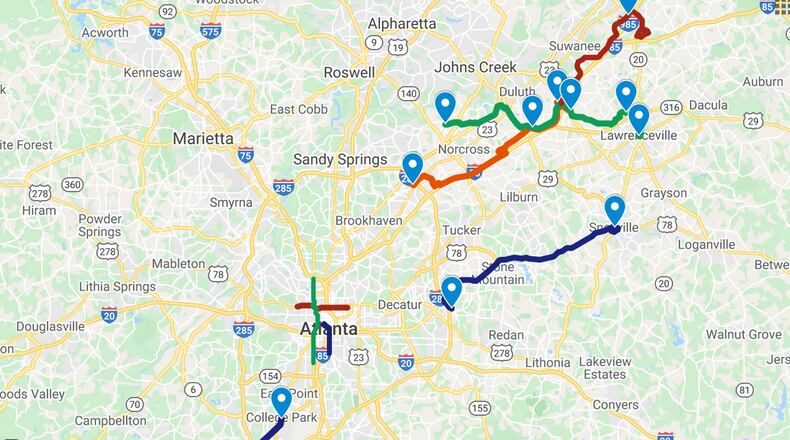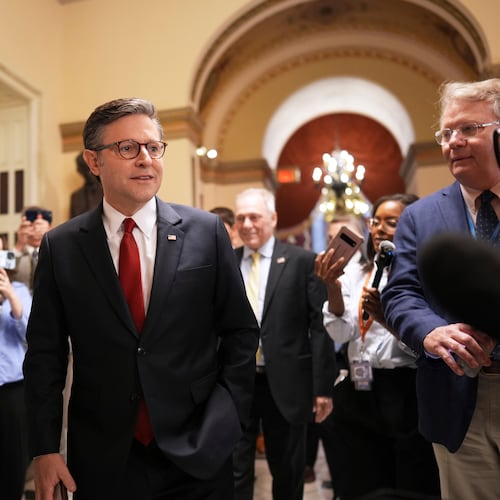At just 2.4 miles from end to end, MARTA’s proposed Capitol Avenue/Summerhill transit line seems like a minor addition to the region’s public transportation network.
But the modest line may have an outsized impact. It’s the first of many bus rapid transit lines planned for metro Atlanta, and it will serve as a model for others to come.
MARTA already has lined up local funding for at least 35 miles of such lines in Atlanta and Clayton County. In November, Gwinnett County voters will consider a transit expansion plan that includes funding for an additional 63 miles of bus rapid transit.
Other lines are in the works in DeKalb and Fulton counties but don’t yet have local funding. Throw in the possibility of similar lines along the top half of the Perimeter and on the Northwest Corridor express lanes in Cobb County, and the region’s bus rapid transit network could eventually dwarf the 48 miles of MARTA rail that serves as the backbone of metro Atlanta’s public transportation system.
That could transform a region known more for its traffic jams than for mass transit.
“It really sets the stage for the most transformational transit implementation we can do in metro Atlanta,” Fulton County Manager Dick Anderson said.
If you’ve never seen bus rapid transit, that’s because it doesn’t exist yet in metro Atlanta. For residents here, “public transportation” means MARTA heavy rail, local bus routes with frequent stops or the state’s commuter buses, which often get stuck in traffic with other vehicles.
Bus rapid transit borrows features from rail lines to speed things up. The vehicles usually operate in exclusive bus lanes or — in some places — in “express lanes” limited to drivers willing to pay a toll.
They stop less frequently than local buses. Passengers board at stations where signs provide real-time information about arriving buses. And passengers pay at the station, not on the bus, which speeds up boarding.
Another feature that appeals to cost-conscious local officials: Bus rapid transit lines can be built at a fraction of the cost of rail lines. According to MARTA, building bus rapid transit costs $20 million to $45 million per mile — compared with $225 million to $275 million for heavy rail and $75 million to $125 million for light rail.
“It really does perform similar to light rail, but at a much lower cost,” Gwinnett Transportation Director Alan Chapman said. “Especially in Gwinnett, we have so much ground to cover. We feel like we can put a lot more miles of bus rapid transit in place than if we went with light rail.”
Gwinnett’s plans for four bus rapid transit lines are subject to voter approval of a 30-year, 1% transit sales tax in November. But voters elsewhere have already approved local funding for bus rapid transit.
In 2014, Clayton County voters approved a 1-cent transit sales tax and agreed to join MARTA. The agency’s plans for Clayton include a bus rapid transit line from College Park station to Southlake Mall and eventually to Jonesboro.
In 2016, Atlanta voters approved a half-cent sales tax for a transit expansion plan that includes bus rapid transit lines on Capitol Avenue, North Avenue and Northside Drive. A fourth transit line along Campbellton Road is tentatively slated to be light rail, but it could become bus rapid transit instead.
The $58.5 million Capitol Avenue/Summerhill line will open first, in 2024. Preliminary plans for the project offer a glimpse of how bus rapid transit service might look elsewhere.
The line would stretch along Hank Aaron Drive and Capitol Avenue from the Atlanta Beltline to the southern part of downtown, looping around Martin Luther King Jr. Drive and Mitchell Street. Along the way, it would pass the Georgia State University Stadium, the Georgia Capitol, Atlanta City Hall and other landmarks. And it would drop passengers near MARTA’s Georgia State and Five Points stations.
The route generally follows a portion of existing local bus Route 55, which runs every 20 to 30 minutes. But the new service would run every 10 to 20 minutes, depending on the day and time.
The route would serve 12 station areas (some areas would have stations on both sides of the street), spaced about every third of a mile. For most of its length it would run in new bus-only lanes. But it would share lanes with other vehicles in a few spots.
MARTA expects to finish about 30% of the design for the project in the next few weeks, with approval of Federal Transit Administration funding coming in September. Construction would begin in 2022.
Heather Alhadeff, MARTA’s assistant general manager of planning, said the Capitol Avenue/Summerhill line will become a showcase that will introduce the region to bus rapid transit.
“I think it’s hard for the typical Atlantan to relate to this because they haven’t experienced it themselves,” she said. “But it really is a raillike experience.”
Other rapid bus routes will follow. The first phase of Atlanta’s North Avenue line is tentatively set to open in 2025. The first phase of Clayton’s line would open in 2026, with the second set for the following year. Gwinnett’s first line — between Sugarloaf Parkway and Jimmy Carter Boulevard via Satellite Boulevard — also could open by 2027. Other Gwinnett and Atlanta lines would follow over many years.
Eventually, bus rapid transit may come to Fulton and DeKalb counties. Fulton officials have discussed a plan to use a portion of the proceeds from next year’s transportation sales tax vote to pay for bus rapid transit on Ga. 400 and South Fulton Parkway.
DeKalb officials have discussed numerous bus rapid transit lines, including routes on I-20, Buford Highway, Memorial Drive and Covington Highway. Ultimately, the region’s developing 120-mile network of toll lanes could double as rapid bus transit lines.
If even a portion of all that comes to pass, it would be a dramatic expansion of transit for the region.
“We don’t fund transit like we should,” Alhadeff said. “Bus rapid transit enables faster project delivery at a lower cost. I think that’s what we need.”
About the Author
Keep Reading
The Latest
Featured





